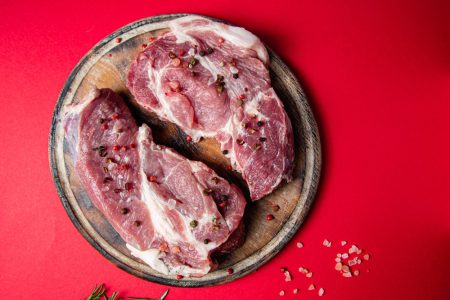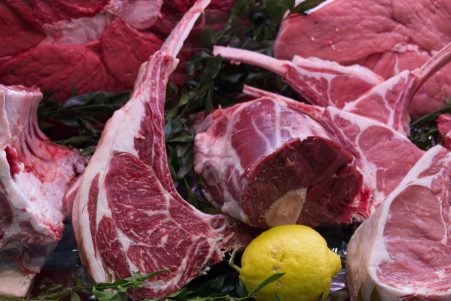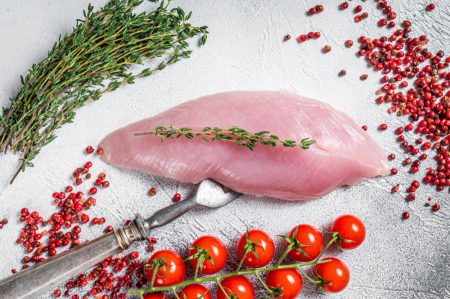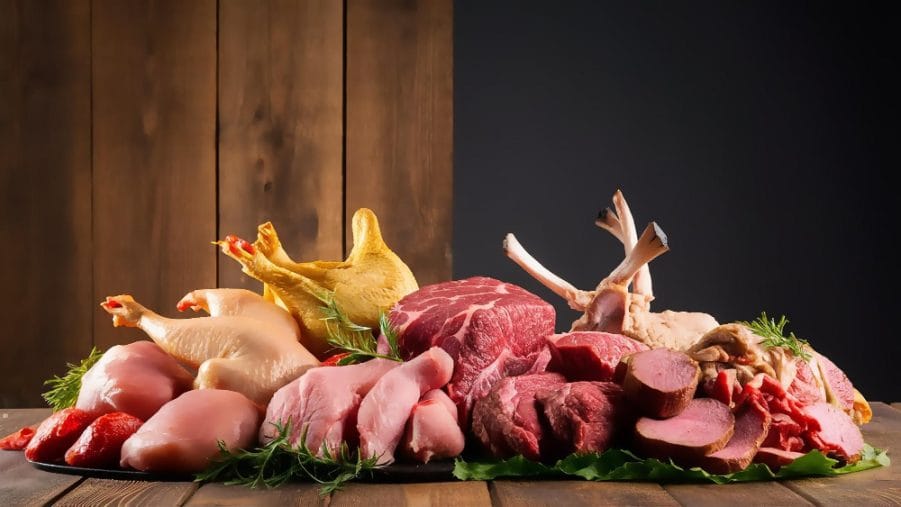1. Introduction to Calories in Meat
What Are Calories and Why Do They Matter?
Calories are the units of energy we derive from food, essential for fueling our bodies. Every activity, from breathing to exercising, relies on calories to function. However, consuming too many or too few can disrupt our health. Understanding how calories contribute to your energy needs is the first step toward maintaining a healthy diet.
The Importance of Understanding Meat Calories
Meat is a staple protein source for many diets worldwide, but it also contributes to calorie intake. The number of calories in meat can vary significantly based on the type, cut, and preparation method. Choosing meat that aligns with your dietary goals requires knowledge about its calorie content. This awareness can help you create meals that are both satisfying and nutritionally balanced.
How Meat Fits Into a Healthy Lifestyle
Calories in meat play a crucial role in providing essential nutrients such as protein, iron, and B vitamins. These nutrients support muscle growth, energy production, and overall health. However, not all meats are created equal. While some options are nutrient-dense and relatively low in calories, others are higher in fat and calorie content, potentially hindering health goals if consumed excessively.
By understanding how meat fits into your overall calorie intake, you can make informed choices that support a healthy lifestyle. Whether you're aiming to lose weight, maintain your current health, or build muscle, choosing the right types and portions of meat is key. Exploring the calories in meat is not just about numbers—it’s about finding a balance that meets your personal needs and preferences.
Affiliate Disclaimer
This blog post may include links to affiliate sites. If you click on an affiliate link and make a purchase, we may earn a small commission or receive other compensation at no extra cost to you. Please note that many of the links on our site are affiliate links. Our use of these links does not impact the products, services, or websites we recommend to you. This disclaimer covers all forms of communication with you, including our website, email, phone, social media, products, and other platforms.
Amazon Affiliate Disclaimer
We participate in the Amazon Services LLC Associates Program, an affiliate marketing program that allows us to earn fees by linking to Amazon.com and its affiliated sites. If you click on an Amazon affiliate link on our site and make a purchase, we may receive a small commission at no additional cost to you.
2. Overview of Calorie Content in Meat
Common Meats and Their Calorie Ranges
When considering calories in meat, the range can vary widely depending on the type and cut. For example, a 3-ounce serving of skinless chicken breast contains approximately 140 calories, while the same serving of ribeye steak can exceed 250 calories. Pork, lamb, and other meats fall somewhere in between, with some cuts being leaner and others more calorie-dense. Understanding these ranges can help you select meats that fit your dietary needs and calorie budget.

Lean vs. Fatty Meats Which Is Better for You?
The distinction between lean and fatty meats is critical when managing calories in meat. Lean meats, such as chicken breast, turkey, and certain cuts of beef like sirloin, are lower in fat and calories, making them ideal for those watching their weight. On the other hand, fattier meats like pork belly, lamb shank, and marbled cuts of beef are higher in both flavor and calories due to their fat content. The choice between lean and fatty meats often depends on your health goals, but balancing taste and nutritional value is always possible with the right preparation.
Why Calories in Meat Vary Across Cuts
The calorie content in meat depends not only on the type of meat but also on the specific cut. For example, dark meat chicken tends to have more calories than white meat due to its higher fat content. Similarly, beef cuts like tenderloin or filet mignon are typically leaner compared to ribeye or brisket. The way meat is trimmed also makes a difference—removing visible fat can significantly lower the calorie count.
3. Calories in Popular Types of Meat
Red Meats Beef, Pork, and Lamb
Red meats are a rich source of protein, iron, and other essential nutrients, but they can also be higher in calories and saturated fat compared to other types of meat. For instance, a 3-ounce serving of lean ground beef contains about 170 calories, while the same serving of a fattier cut like ribeye steak can have over 250 calories. Pork offers a similar range; a lean pork tenderloin has approximately 120 calories per serving, but pork belly or ribs can easily double that. Lamb, often considered a flavorful option, tends to be higher in calories due to its natural fat content, with a typical serving averaging around 250 calories. Being mindful of these calorie variations can help you incorporate red meats in moderation while meeting your dietary goals.

| Red Meat | Calories (per 100g) | Protein (per 100g) |
|---|---|---|
| Beef Sirloin | 206 | 26g |
| Beef Ribeye | 291 | 24g |
| Lamb Leg | 250 | 25g |
| Pork Tenderloin | 143 | 22g |
| Venison | 158 | 30g |
| Bison | 143 | 29g |
| Beef Ground (85% Lean) | 250 | 26g |
| Pork Chop (Lean) | 195 | 22g |
| Mutton | 294 | 24g |
| Veal (Roasted) | 179 | 31g |
Poultry Chicken, Turkey, and More
When it comes to calories in meat, poultry is a popular choice for those seeking lean protein options. Skinless chicken breast is among the lowest-calorie meat choices, with around 140 calories per 3-ounce serving. Turkey is similarly lean, with comparable calorie counts for white meat. However, the calorie content increases significantly when you include the skin or opt for dark meat, which is higher in fat. For example, roasted chicken thigh with skin contains about 200 calories per serving. Other poultry options like duck and goose are richer in flavor but also higher in calories, making them less suitable for low-calorie diets.

| Poultry Meat | Calories (per 100g) | Protein (per 100g) |
|---|---|---|
| Chicken Breast (Skinless) | 165 | 31g |
| Turkey Breast (Skinless) | 135 | 30g |
| Duck (Meat Only) | 190 | 19g |
| Chicken Thigh (Skinless) | 209 | 25g |
| Goose (Meat Only) | 161 | 23g |
| Quail | 134 | 25g |
| Pheasant (Meat Only) | 239 | 24g |
| Guinea Fowl | 158 | 22g |
| Chicken Wings (Skinless) | 203 | 30g |
| Turkey Leg (Skinless) | 170 | 28g |
Seafood The Low-Calorie Powerhouse
Seafood often stands out for its low calorie count and high nutritional value. Fish like cod, tilapia, and haddock provide around 100 calories per 3-ounce serving, making them excellent choices for calorie-conscious eaters. Fatty fish like salmon and mackerel, while higher in calories (around 200 per serving), offer heart-healthy omega-3 fatty acids that justify their inclusion in a balanced diet. Shellfish, such as shrimp and scallops, are also relatively low in calories, averaging about 90 calories per serving, making them ideal for lighter meals.

| Seafood/Fish | Calories (per 100g) | Protein (per 100g) |
|---|---|---|
| Cod | 82 | 18g |
| Salmon (Atlantic) | 208 | 20g |
| Tilapia | 96 | 21g |
| Tuna (Yellowfin) | 130 | 29g |
| Shrimp | 99 | 24g |
| Scallops | 88 | 17g |
| Mackerel | 205 | 19g |
| Haddock | 90 | 20g |
| Crab | 87 | 18g |
| Lobster | 89 | 19g |
Processed Meats Hidden Calories to Consider
Processed meats, including bacon, sausage, and deli meats, can be calorie traps due to added fats, sugars, and preservatives. A single slice of bacon contains around 40 calories, and a sausage link can range from 150 to 300 calories depending on its size and ingredients. Deli meats, such as ham or salami, may seem convenient, but they often contain hidden calories from curing and flavoring agents. When evaluating calories in meat, it’s important to recognize the additional calories in processed varieties and consume them in moderation.
By comparing the calorie content of these popular types of meat, you can make informed choices that align with your health and nutrition goals while still enjoying your favorite dishes.
4. Factors That Influence Calories in Meat
How Cooking Methods Impact Calorie Counts
Cooking methods play a significant role in determining the final calorie content of your meal. Grilling or baking meat is often the healthiest choice, as these methods allow excess fat to drip away, reducing overall calories. For instance, grilled chicken breast retains its lean quality with approximately 140 calories per 3-ounce serving.
Frying, on the other hand, significantly increases calories in meat due to the absorption of cooking oils. Breaded and fried chicken can have up to 300 calories per serving, nearly double that of its grilled counterpart. Similarly, sautéing meat with butter or oil adds additional fats, raising calorie counts considerably. Roasting is another common method that can be calorie-friendly, especially when done without added fats or heavy sauces.
Smoking or slow-cooking meats can also subtly increase calories if sugary marinades or rubs are used. Being mindful of your cooking method is crucial to managing your calorie intake without sacrificing flavor.

The Hidden Calories in Marinades and Breadings
Marinades and breadings often enhance the flavor of meat but can also contribute unexpected calories. Marinades with high sugar content, such as teriyaki or barbecue sauce, can add 50 to 100 calories per tablespoon. Even a seemingly healthy olive oil-based marinade can increase calories in meat by 100 or more, depending on how much is absorbed.
Breadings, commonly used for fried or baked meat, are another calorie booster. Coating meat in breadcrumbs and frying it can add several hundred calories per serving. Opting for alternative coatings, such as crushed nuts or seeds, can provide a healthier, lower-calorie option.
Additives and Fillers What to Look Out For
Processed meats often contain additives and fillers that increase their calorie content. Sausages, for example, may include added starches or fats to improve texture and flavor, significantly boosting calorie counts. Similarly, deli meats can contain sugars and preservatives that elevate their caloric load. When choosing packaged meats, reading nutrition labels can help you avoid these hidden calories in meat and make more informed choices.
Trimming and Preparation Tips to Reduce Calories
The way you prepare meat also influences its calorie count. Trimming visible fat before cooking can significantly reduce calories, especially for fatty cuts of beef or pork. Removing the skin from poultry is another effective way to cut calories while maintaining nutritional value. Simple preparation adjustments can make a significant difference in the calorie profile of your meals.
By understanding the factors that affect calories in meat, you can make thoughtful adjustments to cooking and preparation methods, ensuring your meals are as healthy and calorie-conscious as possible.
5. Strategies for Making Smarter Choices
Choosing Lean Cuts Without Sacrificing Flavor
One of the simplest ways to manage calories in meat is to opt for lean cuts. For beef, this means choosing options like sirloin, tenderloin, or flank steak, which are naturally lower in fat and calories. Similarly, pork tenderloin is a lean alternative to fattier cuts like pork shoulder or ribs. When it comes to poultry, skinless chicken breast and turkey are standout choices for their low calorie counts and high protein content.
To retain flavor while sticking to lean cuts, focus on seasoning with herbs, spices, and citrus. Techniques like marinating in vinegar-based sauces or rubbing with bold spice blends can enhance taste without adding extra calories. Cooking methods like grilling, roasting, or broiling also lock in flavor while keeping calories low.

Portion Control Why Size Matters
Even with lean cuts, portion control is key to managing calories in meat. A standard serving size for meat is about 3 to 4 ounces, roughly the size of a deck of cards. Overeating even the leanest meat can lead to excessive calorie intake, especially if paired with calorie-rich sides or sauces.
Using a kitchen scale or pre-measuring portions before cooking can help you stay on track. Additionally, balancing your plate with vegetables, grains, and legumes can create a more satisfying and nutritionally complete meal without overloading on meat calories.
Pairing Meat with Healthy Side Dishes
What you serve alongside your meat matters as much as the meat itself. Pairing meat with nutrient-rich, low-calorie sides like steamed vegetables, quinoa, or a fresh salad can keep your meal balanced. Avoid calorie-heavy sides like mashed potatoes with butter or creamy pasta dishes, as they can quickly increase the overall calorie count of your meal.
Rotating Meatless Meals for Balance
Incorporating occasional meatless meals is another smart strategy. Plant-based proteins like beans, lentils, and tofu are generally lower in calories compared to most meats and can help balance your overall diet. Rotating these into your routine allows you to enjoy the benefits of a varied diet while reducing your intake of calories in meat.
By combining lean cuts, proper portion sizes, and thoughtful meal planning, you can make smarter choices that align with your health goals while still enjoying the flavor and satisfaction meat provides.
6. Calories in Meat for Special Diets
Low-Calorie Options for Weight Loss Plans
For those aiming to lose weight, selecting meats with the lowest calorie content is essential. Skinless chicken breast is a top choice, with about 140 calories per 3-ounce serving. Other great options include turkey breast and certain types of fish, such as cod or tilapia, which average around 100 calories per serving. These meats are not only low in calories but also high in protein, helping to keep you full while supporting muscle maintenance.
Portion control is especially crucial for weight loss. Even the healthiest meats can contribute to excess calories if consumed in large quantities. Preparing your meat with minimal added fats, such as grilling or baking, can help you stay within your calorie limits while still enjoying flavorful meals. Focusing on low-calorie cuts is a practical way to manage calories in meat and achieve your weight loss goals.

High-Protein, Low-Calorie Meat Choices
If you’re following a high-protein diet, lean meats like chicken breast, turkey, and white fish are excellent choices. These options provide a high protein-to-calorie ratio, allowing you to meet your protein needs without exceeding your calorie intake. For example, a 3-ounce serving of chicken breast offers around 26 grams of protein for just 140 calories.
Seafood like shrimp and scallops is another fantastic high-protein, low-calorie option. These meats are also quick to cook, making them convenient for busy lifestyles. Balancing your meals with low-calorie vegetables and whole grains ensures you’re getting the nutrients you need without unnecessary calories.
Meat Selection for Keto and Low-Carb Diets
For those on a keto or low-carb diet, the focus shifts to meats with moderate to high fat content, which can increase the calories in meat. Ribeye steak, pork belly, and lamb chops are popular choices, as their higher fat content aligns with the keto macronutrient profile. While these options may be higher in calories, they provide sustained energy and are suitable for low-carb plans when eaten in moderation.
To avoid overdoing calories in meat on a keto diet, pair fatty meats with non-starchy vegetables like spinach, zucchini, or broccoli. These additions keep meals nutrient-dense and satisfying without excessive calories.
By tailoring your meat choices to your dietary goals, you can balance calories, protein, and fat intake while enjoying delicious and satisfying meals.
7. FAQs About Calories in Meat
Are Grass-Fed and Organic Meats Lower in Calories?
Many people wonder if grass-fed or organic meats are lower in calories compared to conventional options. While grass-fed beef tends to be leaner, the calorie difference is often minimal, depending on the cut. A 3-ounce serving of grass-fed ground beef has around 160 calories, compared to 170 calories for conventional ground beef. The primary benefit of grass-fed meat lies in its nutrient profile—it often contains more omega-3 fatty acids and antioxidants, making it a healthier option overall. Organic meats also don’t necessarily contain fewer calories, but they may be free of added hormones or antibiotics, offering peace of mind for health-conscious consumers.
How Do Preparation Techniques Change Calorie Counts?
Preparation techniques can have a significant impact on calories in meat. Grilling and baking are among the healthiest methods, as they allow excess fat to drip away while retaining the natural flavors of the meat. Conversely, frying or sautéing meat in oil or butter can add hundreds of calories to your meal. For example, breaded and fried chicken breast can have over 300 calories per serving, compared to 140 calories for a grilled version.
Adding sauces and marinades can also increase calorie counts. Sweet or creamy sauces, like barbecue or ranch dressing, can contribute an additional 50 to 100 calories per tablespoon. For calorie-conscious cooking, stick to simple seasonings like herbs, spices, and lemon juice to enhance flavor without adding unnecessary calories.
What Are the Lowest-Calorie Meat Choices Overall?
If you’re looking to minimize calories in meat, certain types stand out. Skinless chicken breast is a consistent low-calorie option, providing about 140 calories per 3-ounce serving. White fish such as cod, tilapia, and haddock are even lower, with just 100 calories per serving on average. Shrimp and scallops are also excellent low-calorie choices, delivering high protein content with around 90 calories per serving.
For red meat lovers, lean cuts like sirloin, flank steak, or pork tenderloin offer a balanced combination of flavor and low calorie counts. Incorporating these meats into your meals allows you to enjoy satisfying and nutrient-rich options without exceeding your daily calorie goals.
By understanding these common questions, you can make more informed decisions about managing calories in meat while enjoying a variety of delicious, healthy meals.
8. Conclusion
Key Takeaways for Smarter Meat Choices
Calories in meat can vary widely depending on the type, cut, and preparation method. Lean options such as skinless chicken breast, turkey, and white fish are excellent for those aiming to reduce calorie intake while still enjoying nutrient-rich meals. Meanwhile, fattier meats like ribeye or lamb chops may have a higher calorie count but can fit into specific dietary plans like keto or low-carb when consumed in moderation.
Understanding how cooking methods, marinades, and portion sizes impact the calorie content of your meals is essential for making informed choices. Grilling, baking, and roasting are healthier preparation techniques that preserve flavor without adding unnecessary calories. Pairing meat with nutrient-dense sides like vegetables or whole grains ensures a balanced meal that supports your overall health goals.
Encouragement for Building a Balanced Diet
By exploring calories in meat, you gain the knowledge to tailor your meals to suit your individual dietary needs. Whether you’re managing weight, increasing protein intake, or following a specific diet, the key is moderation and variety. With thoughtful planning, you can enjoy the benefits of meat while maintaining a healthy and satisfying diet that aligns with your lifestyle.


